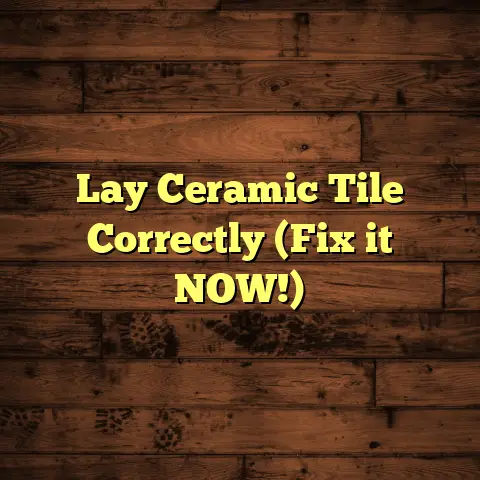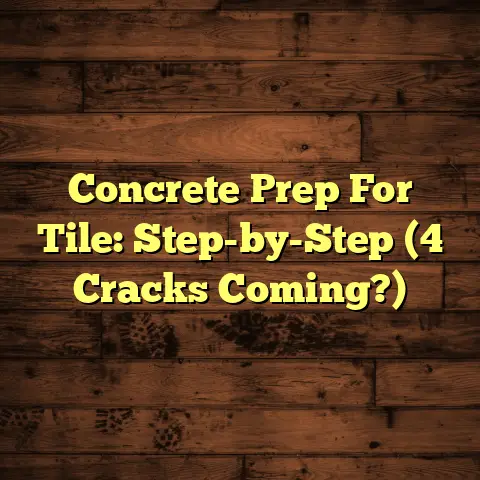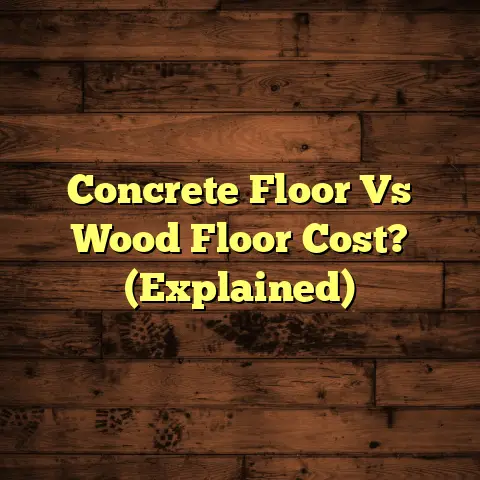Fix Squeaky Mobile Home Floors (7 Silent Solutions!)
Have you ever felt like you’re living in a haunted house, but instead of ghosts, it’s just your floors constantly complaining?
I get it. Squeaky floors in mobile homes are a really common problem, and honestly, they can drive you up the wall.
But before you start thinking about selling and moving to a concrete bunker, let me tell you: there are solutions!
And they’re not as complicated or expensive as you might think.
I’ve been a flooring contractor for over 15 years, and I’ve seen (and heard!) it all.
Let’s dive into how to silence those annoying squeaks and reclaim your peace and quiet.
But first, let’s talk about why this is more than just an aesthetic issue.
The Hidden Health Benefits of a Quiet Home
Okay, I know what you’re thinking: “Health benefits from fixing squeaky floors? Really?”
Yes, really!
Think about it.
A constant barrage of squeaks and creaks can actually impact your well-being more than you realize.
-
Stress Levels: Noise pollution, even the subtle kind from squeaky floors, elevates cortisol levels (the stress hormone). A study published in the “Journal of Environmental Psychology” found a direct correlation between environmental noise and increased stress and anxiety. [^1]
-
Sleep Disruption: Every time you or someone else walks across a squeaky spot, it can jolt you awake or prevent you from falling into a deep sleep. Sleep deprivation leads to a whole host of problems, including weakened immunity, mood swings, and difficulty concentrating. According to the CDC, adults need at least 7 hours of sleep per night, and noise disturbances can significantly impair sleep quality. [^2]
-
Mental Clarity & Relaxation: Your home should be your sanctuary, a place where you can unwind and recharge. Constant noise undermines that, making it harder to focus, relax, and achieve a sense of calm. Imagine trying to meditate with your floor sounding like a symphony of squeaks!
In mobile homes, where space is often limited, these effects can be amplified.
Sound travels easily, and there’s often less insulation to buffer noise.
Fixing those squeaks isn’t just about making your home look and sound better; it’s about investing in your physical and mental health.
Ready to get started?
Let’s figure out why your floors are squeaking in the first place.
Section 1: Understanding the Causes
of Squeaky Floors
Alright, so why are your floors singing the squeaky song?
There are several common culprits, and understanding them is key to finding the right solution.
Here’s a breakdown:
-
Movement of Floor Joists: This is probably the most common reason. Floor joists are the horizontal beams that support your subfloor. Over time, they can warp, sag, or become loose, causing the subfloor to rub against them. That rubbing creates the dreaded squeak.
-
Type of Flooring Materials: Different flooring materials react differently to wear and tear. Laminate flooring, for example, can be particularly prone to squeaking if it’s not properly installed or if the subfloor isn’t perfectly level. Even hardwood floors can develop squeaks as the wood dries out and shrinks.
-
Environmental Factors: Humidity and temperature changes can wreak havoc on your floors. Wood expands and contracts with changes in moisture levels, which can loosen nails and screws and create gaps between flooring materials.
-
Poor Installation Techniques: This one’s a biggie. If your floors weren’t installed correctly in the first place, they’re much more likely to develop squeaks down the road. This could be due to insufficient nailing, inadequate subfloor preparation, or using the wrong type of fasteners.
-
Unique Construction of Mobile Homes: Mobile homes have a unique construction style. They often use lighter-weight materials than traditional homes, which can make them more susceptible to movement and vibration. The chassis of the home can also shift over time, putting stress on the flooring system.
Feature Traditional Home Mobile Home Foundation Permanent Transportable Framing Material Heavier Lumber Lighter Lumber Floor Joists Typically Wider Often Narrower As you can see, the construction differences can significantly impact floor stability and squeak potential.
So, how do you figure out which of these factors is causing your squeaks?
The best way is to do a little detective work.
Walk around your mobile home and try to isolate the areas where the squeaks are the loudest and most frequent.
Pay attention to whether the squeaks occur near walls, in the center of rooms, or in high-traffic areas.
This will give you clues about the underlying cause and help you choose the most effective solution.
Now that we’ve got the “why” covered, let’s move on to the “how”!
Section 2: Solution 1 – Tightening
Floor Joists
Okay, let’s get our hands dirty.
If you suspect that loose floor joists are the culprit behind your squeaky floors, tightening them is a great place to start.
Here’s how to do it:
Tools and Materials You’ll Need:
- Screwdriver or Drill with Screwdriver Bits
- Wood Screws (1 1/4″ to 1 5/8″ are usually good)
- Stud Finder (optional, but helpful)
- Safety Glasses
- Gloves
- Flashlight
Step-by-Step Process:
-
Locate the Squeaky Area: This seems obvious, but it’s important to pinpoint the exact spot where the squeak is coming from. Have someone walk across the area while you listen carefully from below (if you have access to the crawl space).
-
Access the Floor Joists: This is where things can get a little tricky. If you have a crawl space under your mobile home, you can access the floor joists from below. If not, you may need to remove a section of the subfloor to get to them (we’ll talk about that later).
-
Identify the Joist: Once you’re in the crawl space, use your flashlight to locate the floor joists near the squeaky area. They’ll be running perpendicular to the direction of the floorboards.
-
Tighten Loose Connections: Look for any loose nails or screws that are connecting the subfloor to the joists. Use your screwdriver or drill to tighten them. If the screws are stripped, replace them with new ones that are slightly longer.
-
Add Additional Screws: Even if the existing screws seem tight, adding a few more can help to further secure the subfloor to the joists. Drive screws through the subfloor and into the joists every few inches along the squeaky area.
-
Test Your Work: Have someone walk across the area above while you listen from below. If the squeak is gone, you’re golden! If not, try adding more screws or moving on to the next solution.
Tips for Locating Squeaky Areas Effectively:
- Listen Carefully: This sounds obvious, but really focus on the sound. Try to isolate the exact spot where the squeak is coming from.
- Use a Helper: Have someone walk across the floor while you listen from below. This will make it easier to pinpoint the source of the squeak.
- Mark the Spot: Once you’ve located the squeaky area, mark it with a piece of tape or chalk so you don’t lose track of it.
- Check for Obstructions: Make sure there are no pipes, wires, or other obstructions that could be interfering with your ability to access the floor joists.
Tightening floor joists is often the first line of defense against squeaky floors. It’s relatively easy to do, and it can make a big difference.
But what if tightening the joists doesn’t solve the problem?
That’s where shims come in!
Section 3: Solution 2 – Adding Shims
Alright, let’s talk about shims.
These little wedges of wood (or sometimes plastic) are like tiny superheroes when it comes to silencing squeaky floors.
What are Shims and How Do They Work?
Shims are thin, tapered pieces of material that are used to fill gaps and provide support.
In the context of squeaky floors, they’re used to fill the space between the subfloor and the floor joists, preventing them from rubbing together and creating noise.
A Detailed Guide on How to Insert Shims:
-
Locate the Gap: Just like with tightening floor joists, the first step is to identify the exact location of the squeak and the gap between the subfloor and the joist.
-
Prepare the Shim: You can buy shims at most hardware stores, or you can make your own by cutting small wedges of wood. The shim should be slightly thicker than the gap you’re trying to fill.
-
Apply Construction Adhesive: This is optional, but I highly recommend it. Applying a small amount of construction adhesive to the shim will help to hold it in place and prevent it from slipping out over time.
-
Insert the Shim: Gently slide the shim into the gap between the subfloor and the joist. You may need to use a hammer to tap it into place. Be careful not to force it too hard, as this could damage the floor.
-
Test and Trim: Once the shim is in place, walk across the area above to see if the squeak is gone. If it’s still there, try adding another shim or adjusting the position of the existing shim. Once you’re satisfied that the squeak is gone, trim off any excess shim material with a utility knife or saw.
Advantages of Using Shims:
- Simple and Inexpensive: Shims are cheap and easy to install, making them a great option for DIYers on a budget.
- Effective: When used correctly, shims can be very effective at silencing squeaky floors.
- Non-Invasive: Unlike some other solutions, shimming doesn’t require you to remove any flooring or make any major structural changes.
Compared to other methods:
| Method | Pros | Cons |
|---|---|---|
| Shimming | Simple, inexpensive, non-invasive | May not be effective for all types of squeaks, can slip out over time |
| Tightening Joists | Addresses the root cause of the squeak | Requires access to the crawl space, may not be possible in all cases |
| Construction Adhesive | Provides a long-lasting solution | Can be messy, requires ventilation |
Shimming is a fantastic technique to have in your arsenal.
It’s quick, easy, and often does the trick.
But what if the squeaks are coming from between the floorboards themselves?
That’s where lubrication comes in!
Section 4: Solution 3 – Lubricating
the Floors
You might think of lubricant as something you use on your car engine, but it can also work wonders on squeaky floors.
The idea here is to reduce friction between the floorboards, which is often the cause of those annoying squeaks.
Various Lubricants Available:
- Talcum Powder: This is an oldie but goodie. Talcum powder is a fine, dry powder that can be used to lubricate floorboards and reduce friction. It’s best for small squeaks between boards.
- Graphite Powder: Similar to talcum powder, graphite powder is a dry lubricant that can be used to silence squeaky floors. It’s a bit more messy than talcum powder, but it can be more effective for larger squeaks.
- WD-40: Yes, the same stuff you use to silence squeaky door hinges can also work on floors! WD-40 is a penetrating lubricant that can seep into the cracks between floorboards and reduce friction. However, use it sparingly, as it can stain some flooring materials.
- Commercial Floor Lubricants: There are also a number of commercial floor lubricants available that are specifically designed to silence squeaky floors. These products are often more expensive than talcum powder or WD-40, but they may be more effective and longer-lasting.
How to Apply Lubricants Effectively:
-
Identify the Squeaky Area: As always, start by pinpointing the exact location of the squeak.
-
Clean the Area: Use a vacuum cleaner or damp cloth to clean the area around the squeak. This will help the lubricant to penetrate more effectively.
-
Apply the Lubricant: Depending on the type of lubricant you’re using, you may need to apply it differently. For talcum powder or graphite powder, simply sprinkle a small amount of powder over the squeaky area and work it into the cracks between the floorboards with a soft cloth. For WD-40 or commercial floor lubricants, spray a small amount of lubricant onto the squeaky area and allow it to soak in for a few minutes before wiping away any excess.
-
Test Your Work: Walk across the area above to see if the squeak is gone. If it’s still there, try applying more lubricant or moving on to the next solution.
Pros and Cons of Each Type of Lubricant:
| Lubricant | Pros | Cons |
|---|---|---|
| Talcum Powder | Inexpensive, easy to apply, relatively clean | May not be effective for larger squeaks, needs to be reapplied periodically |
| Graphite Powder | More effective than talcum powder for larger squeaks | Messier than talcum powder, can stain some flooring materials |
| WD-40 | Penetrates deeply, effective for a variety of squeaks | Can stain some flooring materials, strong odor |
| Commercial Floor | Specifically designed for squeaky floors, may be longer-lasting | More expensive than other options |
| Lubricants |
Lubricating your floors is a quick and easy way to silence those annoying squeaks. It’s definitely worth a try before moving on to more complicated solutions.
But what if the squeaks are more persistent?
That’s when it’s time to break out the construction adhesive!
Section 5: Solution 4 – Using
Construction Adhesive
When those squeaks just won’t quit, construction adhesive can be your best friend.
This stuff is like super glue for your floors, and it can provide a long-lasting solution for even the most stubborn squeaks.
How Construction Adhesive Works:
Construction adhesive is a strong, flexible adhesive that’s designed to bond building materials together.
When applied to squeaky floors, it fills the gaps between the floorboards and the subfloor, preventing them from moving and creating noise.
Steps for Applying Adhesive:
-
Locate the Squeaky Area: You know the drill by now. Pinpoint the exact location of the squeak.
-
Prepare the Area: Clean the area around the squeak with a vacuum cleaner or damp cloth. You may also need to remove any loose debris or old adhesive.
-
Apply the Adhesive: Using a caulk gun, apply a bead of construction adhesive to the seams and joints around the squeaky area. Be generous with the adhesive, but don’t overdo it. You want to fill the gaps without making a mess.
-
Weigh it Down: Place a heavy object (like a stack of books or a weight) on top of the glued area to hold the floorboards in place while the adhesive dries.
-
Allow to Dry: Allow the adhesive to dry completely according to the manufacturer’s instructions. This could take anywhere from 24 to 72 hours.
Considerations for Application:
- Ventilation: Construction adhesive can release fumes, so it’s important to ventilate the area well while you’re working. Open windows and doors, and use a fan to circulate the air.
- Drying Time: Be patient and allow the adhesive to dry completely before walking on the area. Walking on the area too soon can disrupt the bond and cause the squeak to return.
- Cleanup: Construction adhesive can be difficult to remove once it’s dry, so be sure to clean up any excess adhesive immediately with a damp cloth.
Construction adhesive is a powerful tool in the fight against squeaky floors.
It’s a bit more involved than some of the other solutions we’ve discussed, but it can provide a long-lasting fix for even the most stubborn squeaks.
But what if you want a more permanent solution?
That’s where reinforcing with screws comes in!
Section 6: Solution 5 – Reinforcing
with Screws
Sometimes, the best way to silence a squeaky floor is to simply screw it down!
Reinforcing with screws is a more permanent solution that can help to secure loose floorboards and prevent them from moving and creating noise.
How to Reinforce with Screws:
-
Locate the Squeaky Area: You know the drill. Pinpoint the exact location of the squeak.
-
Choose the Right Screws: Use screws that are long enough to penetrate through the floorboards and into the subfloor, but not so long that they’ll poke through the other side. I usually recommend using screws that are 1 1/4″ to 1 5/8″ long. Also, make sure to use screws that are designed for use with wood.
-
Pre-Drill Pilot Holes: This is important to prevent the wood from splitting. Use a drill bit that’s slightly smaller than the diameter of the screws to pre-drill pilot holes through the floorboards and into the subfloor.
-
Drive in the Screws: Using a screwdriver or drill, drive the screws into the pilot holes. Be careful not to over-tighten the screws, as this could strip the threads or damage the wood.
-
Countersink the Screws: Use a countersink bit to create a small depression around the screw heads. This will allow you to conceal the screws with wood filler or putty.
-
Conceal the Screws: Apply wood filler or putty to the screw holes and smooth it over with a putty knife. Allow the filler to dry completely, then sand it smooth and finish it to match the surrounding floor.
Best Practices for Installation:
- Use a Stud Finder: If possible, use a stud finder to locate the floor joists beneath the subfloor. Driving screws into the joists will provide a more secure hold.
- Stagger the Screws: Don’t drive all the screws in a straight line. Stagger them slightly to distribute the pressure more evenly.
- Use Enough Screws: Don’t be afraid to use plenty of screws. The more screws you use, the more secure the floorboards will be.
Benefits and Drawbacks of This Method:
| Benefits | Drawbacks |
|---|---|
| Provides a more permanent fix for squeaky floors | Requires drilling and screwing, which can be time-consuming and messy |
| Can help to secure loose floorboards and prevent them from moving | Can be difficult to conceal the screws, especially if you’re not experienced with woodworking |
| Relatively inexpensive and easy to do | May not be effective for all types of squeaks |
Reinforcing with screws is a great way to silence squeaky floors for good.
It’s a bit more work than some of the other solutions we’ve discussed, but it’s worth it if you want a long-lasting fix.
But what if the damage is more extensive?
That’s when it’s time to consider replacing damaged boards.
Section 7: Solution 6 – Replacing
Damaged Boards
Sometimes, squeaky floors are a sign of something more serious: damaged or warped floorboards.
In these cases, the best solution is to simply replace the damaged boards.
When and How to Replace Boards:
-
When: Replace damaged or warped floorboards when they’re causing significant squeaks, when they’re structurally unsound, or when they’re unsightly.
-
How:
-
Identify the Damaged Boards: Carefully inspect your floors to identify any boards that are damaged, warped, or otherwise in need of replacement.
-
Remove the Damaged Boards: Use a pry bar or chisel to carefully remove the damaged boards. Be careful not to damage the surrounding boards.
-
Prepare the Area: Clean the area where the old boards were removed. Remove any old nails, screws, or adhesive.
-
Cut the New Boards: Measure the length of the old boards and cut the new boards to the same length.
-
Install the New Boards: Apply construction adhesive to the subfloor and carefully position the new boards in place. Use a hammer and tapping block to gently tap the boards into place.
-
Secure the New Boards: Use nails or screws to secure the new boards to the subfloor.
-
Finish the New Boards: Sand the new boards smooth and finish them to match the surrounding floor.
-
Selecting the Right Materials:
- Match the Existing Flooring: When selecting new boards, be sure to choose materials that match the existing flooring in terms of species, color, and grain.
- Consider the Thickness: Make sure the new boards are the same thickness as the old boards.
- Choose High-Quality Materials: Invest in high-quality materials that will last for years to come.
Addressing Underlying Damage:
- Inspect the Subfloor: When you remove the old boards, take the opportunity to inspect the subfloor for any signs of damage. If you find any damage, repair it before installing the new boards.
- Check for Moisture: Moisture can cause floorboards to warp and squeak, so it’s important to check for any signs of moisture. If you find any moisture, address the source of the moisture before installing the new boards.
Replacing damaged boards is a more involved process than some of the other solutions we’ve discussed, but it’s often the only way to truly silence squeaky floors.
But what if you’re not comfortable doing this kind of work yourself?
That’s when it’s time to call in the pros!
Section 8: Solution 7 – Seeking
Professional Help
Let’s be real, sometimes DIY isn’t the answer.
If you’re feeling overwhelmed, unsure, or if you’ve tried the other solutions and nothing seems to be working, it might be time to call in a professional.
Scenarios Where Professional Help is Best:
- Extensive Damage: If your floors are extensively damaged or warped, it’s best to leave the repairs to a professional.
- Structural Issues: If you suspect there are structural issues with your floors, such as damaged floor joists, it’s important to consult with a professional.
- Lack of Experience: If you’re not comfortable working with tools or if you’re not experienced with home repairs, it’s best to hire a professional.
- Time Constraints: If you don’t have the time to tackle a DIY project, it’s worth considering hiring a professional.
Tips on Choosing a Qualified Contractor:
- Get Referrals: Ask friends, family, and neighbors for referrals to qualified contractors.
- Check Online Reviews: Read online reviews of contractors in your area.
- Get Multiple Bids: Get bids from multiple contractors before making a decision.
- Check Licensing and Insurance: Make sure the contractor is licensed and insured.
- Ask Questions: Ask the contractor plenty of questions about their experience, their process, and their pricing.
What to Expect From the Process:
- Initial Consultation: The contractor will come to your home to assess the problem and provide you with a bid.
- Preparation: The contractor will prepare the area for repairs. This may involve removing furniture, covering floors, and setting up dust barriers.
- Repairs: The contractor will make the necessary repairs. This may involve tightening floor joists, adding shims, applying construction adhesive, reinforcing with screws, or replacing damaged boards.
- Cleanup: The contractor will clean up the area after the repairs are complete.
Long-Term Benefits of Professional Intervention:
| Benefit | Description |
|---|---|
| Peace of Mind | Knowing that the repairs are being done correctly by a qualified professional. |
| Long-Lasting Results | Professional repairs are more likely to last for years to come. |
| Avoidance of Costly Mistakes | Professionals have the experience and knowledge to avoid costly mistakes. |
| Increased Home Value | Well-maintained floors can increase the value of your home. |
Hiring a professional is an investment in your home and your peace of mind.
While it may cost more upfront, it can save you time, money, and headaches in the long run.
Conclusion: A Silent Home,
A Happier You
Alright, we’ve covered a lot of ground here.
From understanding the causes of squeaky floors to exploring seven different solutions, you’re now armed with the knowledge you need to silence those annoying squeaks for good.
Remember, addressing squeaky floors isn’t just about aesthetics or convenience.
It’s about creating a healthier, more peaceful living environment for yourself and your family.
A quiet home reduces stress, improves sleep, and enhances mental clarity.
It’s a place where you can truly relax, recharge, and be yourself.
So, take action!
Choose the solution that’s right for you, and get to work.
Whether you’re tightening floor joists, adding shims, lubricating the floors, using construction adhesive, reinforcing with screws, replacing damaged boards, or seeking professional help, every step you take towards a quieter home is a step towards a happier, healthier you.
You deserve a peaceful home, and I know you can achieve it.
Now go forth and silence those squeaks!
References [^1]: Journal of Environmental Psychology [^2]: Centers for Disease Control and Prevention





